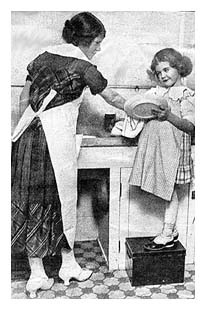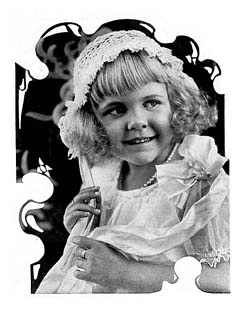
by Tim Lussier

They called her "The Dresden Doll of the Movies," "The Youngest Emotional Star" and a host of other "titles" during her short, but spectacular, reign as the most popular child star in the movies. An article from the 1930's referred to her as the "Shirley Temple of her day," which may give today's silent movie fan some sense of Virginia Lee Corbin's popularity in the late 'teens.
She was born Virginia LaVerne Corbin, later
changing the LaVerne to Lee, in Prescott, Ariz., December 5, 1910,
to Leon E. and Frances Cox Corbin. Many sources give her birthdate
as 1912, but that could have been attributed to her parents who
may have wanted her to appear younger than she was as a child
actress.
Publicity from the late 'teens noted she "gave evidence of extraordinariness by talking at age 11 months. She also displayed unusual emotional ability at an early age - that is, she cried. When she was three, Virginia could sing, in key, anything that she had heard more than once. She had a wonderful memory, even at that early age, and was a remarkable dancer."
Another source said, "When this tiny lass came to be three years old, everybody started noticing her beauty, and though she was only a frail little being, her mind was developed far more than one would expect, and when she learnt to talk, she never spoke a baby word. She seemed to have a wonderful memory, also, and easily learnt all kinds of songs, stories and poems by heart." As this article pointed out, Virginia was not only talented, she was a beautiful child. At two years of age, she posed for the Art Calendar Company of New York, among other modeling jobs.
Virginia's mother was reportedly an actress
which, no doubt, led to her daughter's appearance when she was
three years old in a popular melodrama of the day entitled "Human
Hearts." (Another play is mentioned in an undated article
entitled "The Regeneration of John Gray" in which she
played cupid. The article said she was three and a half years
old, placing this performance sometime during 1913.) In an interview,
her mother said, "She used to get so tired between acts that
I'd make a bed of coats on a trunk and let her sleep. She was
always remarkably bright. She is naturally a great dramatic actress."
"Human Hearts," the article said, played for three seasons,
which would have made Virginia five or six years old when it closed.
Then "Mrs. Corbin found herself at a hotel in Long Beach
. . ."
It is not known when the Corbins left Arizona, but they apparently moved quite often. One source says Virginia became quite ill when she was three and her parents "had to leave their beautiful Eastern home and take the tiny girl to California." After arriving in California, they still continued to move quite a bit in spite of the fact that L.E. Corbin was a druggist. He was the owner of Corbin Drug Store in San Diego, CA., on the corner of Fifth and Broadway, prior to their moving to Los Angeles in 1915. Another, undated source states, "L.E. Corbin, the new druggist at J.W. Norton's Drug Store, comes from Hollywood. Mr. Corbin was formerly employed at the Oakford Drug Store in Long Beach." Still another refers to Mr. L.E. Corbin "of Santa Ana" where he apparently was employed by the Park Drug Company.
How Virginia actually got started in the movies is also not clear. At least one article from the time says she was performing in a hotel "where the child attracted the attention of Ellen Beach Yaw." Commenting on her "find" in the late 'teens, Yaw said, "Virginia wasn't doing anything at all then but posing for artists and entertaining at hotels. Everyone told me to put her into moving pictures. So I took her to Pathé Fréres, and they put her to work right away."
Another version of her entrance into motion pictures stated, "In 1915, Virginia's mother and father moved to Los Angeles. Mrs. Corbin decided to take a look at the motion picture studios. She took Virginia with her one day when she visited the studios. One of the directors saw her and insisted on her working a day in a production he was making. She did. That was the beginning. She made so good that they would not let her get away from pictures."
 Still
another article stated, "It was while she was watching her
sister one day that a director spied her and placed her in her
very first picture, 'The Chorus Girl and the Kid'." Virginia's
sister, Ruth, who was three years older, was also an actress,
but she was obviously overshadowed by her younger sister, and
little information can be found on her. Ruth was described as
". . . really beautiful with the deep gray eyes denoting
the artistic temperament, fluffy brown hair and perfect features."
Ruth reportedly made her first appearance in a movie for the Horkheimer
Brothers at Balboa, although the year is not known.
Still
another article stated, "It was while she was watching her
sister one day that a director spied her and placed her in her
very first picture, 'The Chorus Girl and the Kid'." Virginia's
sister, Ruth, who was three years older, was also an actress,
but she was obviously overshadowed by her younger sister, and
little information can be found on her. Ruth was described as
". . . really beautiful with the deep gray eyes denoting
the artistic temperament, fluffy brown hair and perfect features."
Ruth reportedly made her first appearance in a movie for the Horkheimer
Brothers at Balboa, although the year is not known.
One early article stated, "Friends of baby Virginia Corbin, three years old, will be pleased to know that she made her debut in motion pictures last week, featured with Miss Marie Empress, London star, in an emotional play (which is the previously mentioned "The Chorus Girl and the Kid"). Those associated with the Balboa company as well as her many friends, were much surprised at her clever work. Baby Virginia is the rare blonde type so much sought by picture companies, and, aside from being a beautiful child, she is extraordinarily bright. She is a sister of Ruth Corbin, the six-year old child film favorite playing with the Balboa company." Virginia made at least one picture for Yorke-Metro in 1916 entitled "Pidgin Island" with Harold Lockwood and May Allison.
A 1916 fan magazine reported, "Virginia Corbin, the four-year old, no sooner completed a picture this week for Yorke-Metro than she was called to Universal to be featured in a series of pictures by Allen Holubar." Another says she was with the Lule (sometimes "Lulu") Warrenton juvenile company at Universal. "The Warrenton company is the first juvenile company to be organized that plays children only . . ."
Contemporary accounts mention her appearance in "Behind Life's Stage," a medieval romance written and produced by Allen Holubar, "Nannette" with Flora Parker DeHaven, and "The Castle of Despair" with Neva Gerber and Malcolm Blevins. "The Castle of Despair" is mentioned as being three reels, however, the length of the other two is not known, and they are not listed in the American Film Institute's (AFI) Catalog of Feature Films, probably indicating they were less than "feature" length (one article said she was featured in six "three-reel photoplays" at Universal). There is also mention that she had appeared in a film with Geraldine Farrar.
The first feature listed for Virginia in the AFI Catalog of Feature Films is "Heart Strings," a Universal release of Jan., 1917, starring Allan Holubar (who also directed), Francelia Billington, Paul Bryon and Maude George. She apparently had a small part portraying Billington's character as a child. Exactly when she completed work on "Heart Strings" is not known, but by October, 1916, she had signed with the Fox Film Company, a move that put her well on her way to becoming the most popular child star of the day.
Copyright 2000 by Tim Lussier. All rights reserved.